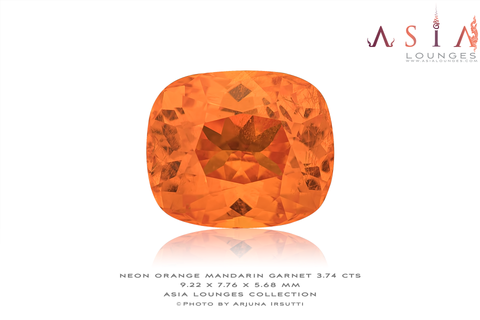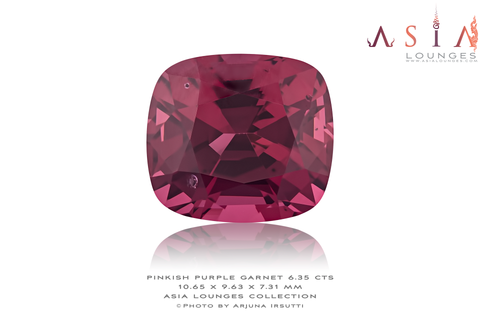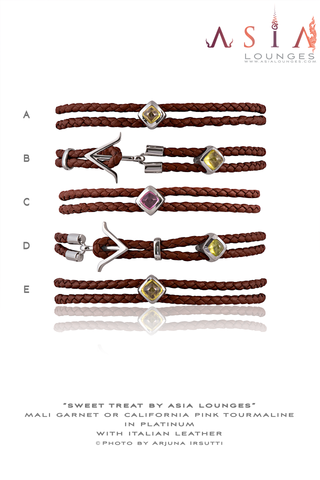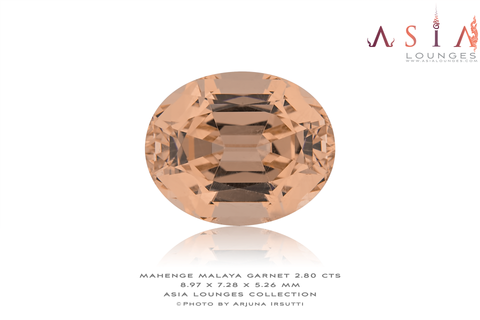The Garnet family provides gems for all Seasons.
The oranges of autumn leaves, the glowing red coals of a winter fire, the sparkling green of a summer field, and the beautiful pinks of spring flowers, garnet is a gemstone for all seasons. Garnets are a closely related group of gemstones that are available in every color. Dark reds, tangerine orange, vivid lime green, soft bluish-pink, garnet is all these colors and more.
You can see here an example of a Pink garnet from the early AsiaLounges collection - Photography by Arjuna Irsutti Photography
There are garnets that change color in different light, translucent green garnets that look like jade, garnets with stars, garnets that have been mined for thousands of years and garnets that were just discovered in the last decade.
Garnets have long been carried by travellers to protect against accidents far from home. In ancient Asia and the American Southwest, garnets were used as bullets because the glowing red color was said to increase the ferocity of a wound. Garnets in legend light up the night and protect their owners from nightmares. Noah used a garnet lantern to navigate the Ark at night. The ancient world is full of praise for the carbuncle, the glowing red coal of a gemstone we now know as garnet.
Here is a selection of Sweet Treat Bracelets by AsiaLounges featuring a Mali Garnet gem on platinum - Photography by Arjuna Irsutti Photography
The name garnet probably comes from pomegranate. Many ancient pieces of garnet jewelry are studded with tiny red stones that do look a lot like a cluster of pomegranate seeds! Jewelry set with garnets from Czechoslovakia was extremely popular in the nineteenth century and Bohemian garnet jewelry is still popular today, although today the garnets are mined elsewhere. When you say garnet, most people think automatically of small dark red gemstones, even though this is only one aspect of the world of garnets.
Garnet is the birthstone for January, which means that January babies have a lot of choices! Varieties available, some mineral differences and some color descriptions, include rhodolite, malaya, demantoid, grossular, hessonite, spessartite, almandine, mandarin and combinations between these varieties.
Here is a prime example of the infamous Malaya Garnet - Find more here - Photography by Arjuna Irsutti Photography
One of the most popular is rhodolite garnet, which ranges from pink to purplish red in color and is mined in Africa, India, and Sri Lanka. Tsavorite garnet is a bright yellow green to grass green, and is mined in Tanzania and Kenya. The legendary demantoid garnet combines a bright green with dazzling brilliance that won over the Tsars of Russia, who used it lavishly. In the past, demantoid garnet was only ever available in small sizes and was extremely rare, but a new deposit was found in 1998 in Namibia, southern Africa. However, it is still quite rare today.
Malaya garnet, another popular mixed variety, ranges from orange to gold and is mined in Tanzania and Kenya. Pyrope garnet is a very saturated red: beautiful small pyrope garnets found in Arizona are called anthill garnet because they are mined by ants, who carry them up when they are excavating their anthills.
One garnet growing in popularity is a newly discovered garnet from Namibia, which is a bright orange spessartite, is called mandarin garnet because its color is a true orange. Hessonite and Spessarite garnets mostly come in golds, oranges and browns that are sometimes called cinnamon garnets. Grossular, the variety of garnets that gives us tsavorite, also is available in pale pinks, greens or yellows.

While this particular Gem is not from Namibia, its color and texture are reminiscent of it - Find more here - Photography by Arjuna Irsutti Photography
Garnets are fairly hard and durable gemstones that are ideal for jewelry use, except for demantoid, which is softer and requires more protection.
©Jeffery L Bergman, SSEF SGC



